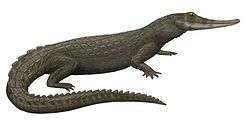Eusuchia
| Eusuchia Temporal range: Early Cretaceous - Recent, 130–0 Ma | |
|---|---|
 | |
| Three species of living eusuchian: Gharial (left), American Alligator (center), and American Crocodile (right). | |
| Scientific classification | |
| Kingdom: | Animalia |
| Phylum: | Chordata |
| Class: | Reptilia |
| Superorder: | Crocodylomorpha |
| Clade: | Neosuchia |
| Clade: | Eusuchia Huxley, 1875 |
| Subgroups | |
The Eusuchia ("true crocodiles") are a clade of crocodylomorphs that first appears in the Early Cretaceous with Hylaeochampsa.[1] Along with Dyrosauridae and Sebecosuchia, they were the only crocodyliformes who survived the K-T extinction. Since the other two clades died out 35 and 11 million years ago, all living crocodilian species are eusuchians, as are many extinct forms.
Description
Unlike primitive crocodylomorphs, crocodyliforms have secondary bony palates. This feature enables living crocodylians to safely breathe in through their nostrils while the rest of the head (including the mouth) remains submerged. This structure reaches its greatest elaboration among eusuchians, in which the internal nares are completely surrounded by the pterygoid bones.
Phylogeny
Cladogram after Holliday and Gardner, 2012:[2]
| Eusuchia |
| |||||||||||||||||||||||||||
| |
Below is a cladogram after Puértolas, Canudo and Cruzado-Caballero, 2011:[3]
| Eusuchia |
| ||||||||||||||||||||||||||||||||||||
| |
References
- ↑ Benton, Michael J.; Sibbick, John (2000). Vertebrate Palaeontology. Blackwell Publishing. p. 233. ISBN 0-632-05614-2.
- ↑ Casey M. Holliday and Nicholas M. Gardner (2012). "A New Eusuchian Crocodyliform with Novel Cranial Integument and Its Significance for the Origin and Evolution of Crocodylia". PLoS ONE. 7 (1): e30471. doi:10.1371/journal.pone.0030471. PMC 3269432
 . PMID 22303441.
. PMID 22303441. 
- ↑ Eduardo Puértolas, José I. Canudo and Penélope Cruzado-Caballero (2011). "A New Crocodylian from the Late Maastrichtian of Spain: Implications for the Initial Radiation of Crocodyloids". PLoS ONE. 6 (6): e20011. doi:10.1371/journal.pone.0020011. PMC 3110596
 . PMID 21687705.
. PMID 21687705. 

